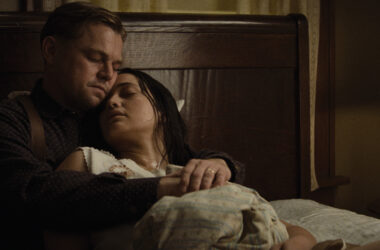In Agnes Varda’s “Cleo From 5 To 7” the filmmaker dwells upon the nature of symbolism and her own work. Varda, mostly famous for her wildly varied canvas of colorful images and characters, strips it all away to tell the story of a woman in a lifeless world. Even though most of the film is in black and white, the cards at the start are shown through both an eye of God shot and with colors. Both the assertive nature of such shot and its colors effectively convey the point that, on a symbolic sense, that moment and it’s superstitious effect on her represents where the vivid imagination relies, it too dwells upon the game of life and death Cleo finds herself in during that very long day. As the picture follows, most images rely on mirrors, heavily persistent upon the argument of Cleo’s perception of herself. Of a young, beautiful and untouchable woman, now ravished by the possibility of death. Resented by her own circle for her beauty and youthful figure, Cleo’s life appears to be in the hands on none other than herself. Varda, highly assertive in her intentions, tells Cleo, as God would, that while appearing imminent, doom is not the only happening.
Varda’s expectation and view of Cleo is left unclear for most of the film, yet the transformation their relationship takes throughout the picture is not. Varda and her movie camera appear just slightly behind Cleo as it pertains to information. Many times, Cleo will realize something and we end up waiting for the camera and editing of the picture to catch up. Varda is a voyager that, only on occasions, through compositions, will be ahead of Cleo, almost dictating her world. Thy however, is only present in moments of deep self reflection, such as when Cleo leaves the card reader at the start of the film. The music halts the editing towards a repetition and the composition maps out Cleo’s movement. When she finds herself in a downward spiral or overwhelmed by others around her, is when Varda and Cleo become one. Once Cleo begins to wear black and somewhat embreasses the overwhelming doom within her, Cleo becomes a voyager in observing others, much like Varda did to her. At that point, Cleo’s mirror is broken, and her eyes are that of God, seeing only the full picture of doom put upon her. By that, one could speculate how Agnes relates to her main character, and how personal of a picture this is for her.
“It’s like being asleep”
Cleo’s conversation with the model is a fascinating one, for she explains to Cleo the difference between the self and the perception others place upon a woman. “They see a shape, an idea, it’s like sleep. I’m not even there”.
These words showcase the crisis Cleo finds herself in, for a woman with such undeniable youth and beauty, Cleo was, in a sense, her vapid image defined by the looks around her, yet when faced upon the idea of death, only what is truly real can commend. She is forced to question, and address what she holds inside her. In a lot of ways, stop being a child, and become a woman.
“I’ve the feeling my fear is gone”
On its final moments, Cleo wanders a park as we experience every little moment and minute of such. You see, like most French new wave directors, Varda wasn’t doing experimentation simply for experimentation’s sake. The mundane moments we experience with Cleo; elongated walks and waits all contribute towards how precious and filled with dread such a casual day can be. Varda’s perception of time is one of her most captivating interests after all. Her little tweaks in the editing to advance milliseconds are like short memories that are lost with time. Those little seconds lost are made so abrupt for by the end of the picture, both Cleo and Varda make a straight point to say that the moment is what counts. Every second, in the living present, fearless, is a blessing.
The most transformative shot in the picture comes through a tracking shot of the trees. A shot much similar to previous ones, except this time without judgmental looks or overwhelming amounts of people. This shot, that before served as a POV, a mash of Varda and Cleo’s world, slowly separated them this time around. The picture served as a lesson for Varda. Cleo spends a lot of film engulfed in Varda’s position as a director, of always looking at the full picture, being the POV and yet, by the end, Cleo teaches Varda a lesson, and makes her into her own picture. As Cleo walks in the shot right in front of the trees, she, and Varda, are no longer looking at the full picture, and are now, even if slowly, learning how to be a part of it.
Related Posts
The Man From Laramie – Which M?
Money Or Morals? In Mann’s 1955 experimentation he marks a vital piece in his collaboration with Jimmy Stewart,…
Killers Of The Flower Moon – Scorsese’s Genre defining masterpiece
The fate of any western made after 1969 is self reflection. Self reflection of a genre that by…
Saving Private Ryan: The Weaknesses of Spielberg
My first time watching since I was 13 after reading Anthony Beevor’s excellent book about D-Day. Saving Private…



